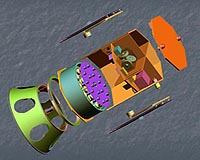 |
Pasadena CA (SPX) Jul 29, 2009 The Australian government has announced that it will provide $88.4 million AUD ($72.4 million USD) to help fund the revolutionary 25-meter Giant Magellan Telescope (GMT) to be sited at Las Campanas Observatory in Chile's high-altitude Atacama Desert. This brings the funding that has been raised to date to $200 million out of approximately $700 million total needed to complete construction, which is scheduled for 2019. The GMT will be built and operated by a consortium of institutions from the United States, South Korea, and Australia. Larger and more powerful than any previous optical telescope, it will be up to 100 times more sensitive than current ground-based telescopes, and will produce images 10 times sharper than those from the Hubble Space Telescope. GMTO Corporation Board Chairperson and Carnegie Observatories director, Wendy Freedman said, "We are delighted at the success of our Australian colleagues. This funding will give Australian astronomers access to about 10% of the time on the GMT, and assure that they remain at the forefront of astronomical research. It provides another strong boost of forward momentum for the project, one of many it has received of late." Harvey Butcher, Director of the Australian National University Research School of Astronomy and Astrophysics and Mount Stromlo Observatory said, "Involvement in GMT will strongly advance Australia's contributions to science and innovation and provide a focus for attracting the next generation of scientists and engineers." "Australia's action strengthens the GMTO and will help us build the telescope we dream of in Chile. To achieve this dream takes money, talent, and grit. The Australians are bringing all three," said Patrick McCarthy, director of the GMTO. The GMT will combine seven 8.4-meter primary mirror segments resulting in an equivalent 24.5-meter telescope. It will be used to explore currently unanswered questions about the nature of dark matter and dark energy, the origin of the first stars and first galaxies, and the mysteries of star formation, galaxy evolution, and black hole growth. The GMT will also play a key role in the detection and imaging of planets around nearby stars. In the United States the participating institutions are the Carnegie Institution for Science, Harvard University, the Smithsonian Institution, Texas A and M University, the University of Arizona, and the University of Texas at Austin. The two Australian members of the Founders group are the Australian National University and Astronomy Australia Limited. Earlier this year, the South Korean government approved participation in the GMT project, with the Korea Astronomy and Space Science Institute as the representative of the Korean astronomical community. Share This Article With Planet Earth
Related Links Giant Magellan Telescope Organization (GMTO) Space Telescope News and Technology at Skynightly.com
 China's First Space Telescope Anticipated To Be Launched In 2012
China's First Space Telescope Anticipated To Be Launched In 2012Beijing (XNA) Jul 27, 2009 The predicted launch time of China's first space telescope is in 2012, and will be used to observe space black holes, said the chief scientist of the program Thursday. The Hard X-ray Modulation Telescope (HXMT) comprises three to four single telescopes equipped with hard X-ray detectors, instead of optical lenses, said Li Tipei, an academician with the Chinese Academy of Sciences (CAS). ... read more |
|
| The content herein, unless otherwise known to be public domain, are Copyright 1995-2009 - SpaceDaily. AFP and UPI Wire Stories are copyright Agence France-Presse and United Press International. ESA Portal Reports are copyright European Space Agency. All NASA sourced material is public domain. Additional copyrights may apply in whole or part to other bona fide parties. Advertising does not imply endorsement,agreement or approval of any opinions, statements or information provided by SpaceDaily on any Web page published or hosted by SpaceDaily. Privacy Statement |